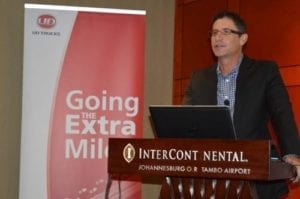2013 was a good year for the South African truck market surpassing all expectations. Sales increased by 11.12% on 2012’s full-year results, reaching a noteworthy 30 936 units despite a number of key challenges posted by the local political and economic environment.
According to the combined results released by the National Association of Automobile Manufacturers of South Africa (Naamsa), Associated Motor Holdings (AMH) and Amalgamated Automobile Distributors (AAD), all segments in commercial vehicle market, except for buses, showed growth when compared to 2012’s results. Sales in the Medium Commercial Vehicle (MCV) segment increased by 14.66% to 11 585 units, while the Heavy Commercial Vehicle (HCV) segment showed a 9.94% growth to conclude the year on 5 477 units.The Extra Heavy Commercial Vehicle (EHCV) segment experienced significant growth of 10.39%, selling 12 828 units during 2013. Jacques Carelse, managing director of UD Trucks Southern Africa, says, “There were a number of growth factors driving truck sales upwards last year.” “Fast Moving Consumer Goods and daily commodities were the main drivers of sales, especially in the high volume MCV and HCV segments, contributing 55.01% to the growth of the truck market during 2013. Construction, even though it is traditionally a low volume contributor to truck sales, experienced a very high growth rate on the back of a number of Strategic Infrastructure Projects, and made up 39.05% of the industry’s growth last year.” Another transport segment that made a significant contribution was demanding long-haul (29.82%), which is usually a high volume segment but faced some growth challenges due to the improvement of the country’s rail infrastructure and capacity, as well as a slowdown in mining production.Improvements in waste collection and recycling spurred sales in the waste and public utilities segment and contributed 14.78% to the truck market’s growth. Carelse adds, “Despite facing a number of macroeconomic challenges that included a downgrade of the country’s GDP, the depreciation and volatility of the Rand and a slow economic recovery in Europe, the South African truck market still managed to perform exceptionally well.” During 2013 a total of 1 202 trucks were exported by South African manufacturers, an increase of 11.71% when compared to 2012’s figures. “The weaker Rand should raise demand for exports in the year to come as a weak global demand is not allowing the currency to gain more value at this stage.The weaker Rand will also, of course, have a negative impact on truck prices and a number of manufacturers are expected to announce price increases over the next few months,” explains Carelse. During 2013, UD Trucks comfortably retained its fourth position in the market, and was once again the top selling HCV brand with a 24.16% share of the market.The company also made significant inroads in the EHCV segment, growing sales of its Quon range by 18.57% to capture an 8.76% market share. Outlook 2014 Rory Schulz, general manager of corporate planning and marketing at UD Trucks Southern Africa, says, “The country’s failure to generate faster growth is problematic and could cause some significant challenges for the local truck market in 2014.” “Gross Fixed Capital Formation or GFCF, the new value that is added to the economy, is set to increase slightly during 2014 with the main gains coming from several construction and infrastructural projects. Government’s New Development Plan, although met with mixed reactions, has also now for the first time been included in the state budget and bodes well for the development of a number of the Strategic Infrastructure Projects or SIPs identified by government.” The SIPs include 18 projects ranging from geographically-focused developments, to social infrastructure, knowledge, water and sanitation.Most of these projects require heavy involvement by the transport industry, which could once again have a positive impact on the potential growth of the market. Schultz explains, “While we expect interest rates to remain basically unchanged during 2014, one also has to consider the impact of the national elections and labour on the performance of the country’s economy.” UD Trucks expects the total truck sales to increase by 4.93% during 2014 to reach an expected 32 550 units.This forecast includes an increase in sales across all the segments:
Segment Growth Forecast 2014
MCV 4.96% 12 200
HCV 5.57% 5 800
EHCV 4.98% 13 500
Bus 0.38% 1 050
Total 4.93% 32 550*
*Includes Naamsa, AMH and AAD.
UD Trucks in 2014 & Beyond
UD Trucks Southern Africa is set for a ground-breaking era during the next five years and is planning the introduction of game-changing new products and services to customers.
Carelse says, “The future plans of UD Trucks are all about enhancing our customers’ transport and service experience with us. We are committed to supporting our customers in a smart and modern way, and going the extra mile in everything we do.”
As has always been the case, UD Trucks will provide customers with transport solutions that offer the right balance between features, cost and efficiency.
UD Trucks is also constantly developing, strengthening and training its already comprehensive regional dealer network.The 64 UD Trucks dealers across southern and eastern Africa are always ready to support customers with manufacturer-endorsed sales, service, parts, as well as financial and fleet solutions.
Represented all along the major routes and trade corridors across the region, UD Trucks Southern Africa is able to provide a speedy response, knowledgeable technical advice and service, as well as ultimately dependable trucks that get the job done.
UD Trucks Southern Africa has also invested more than R4.8 million over the past two years in the training of its staff and members of the community in various developmental and training programmes.
Concludes Carelse, “We passionately believe in the vital importance of training and investing in the future of our employees and surrounding community. The objective of the programme is to provide on-going developmental opportunities that not only allow us as a company to achieve our business objectives, but also to empower and contribute to the overall development of the participating learners.”








